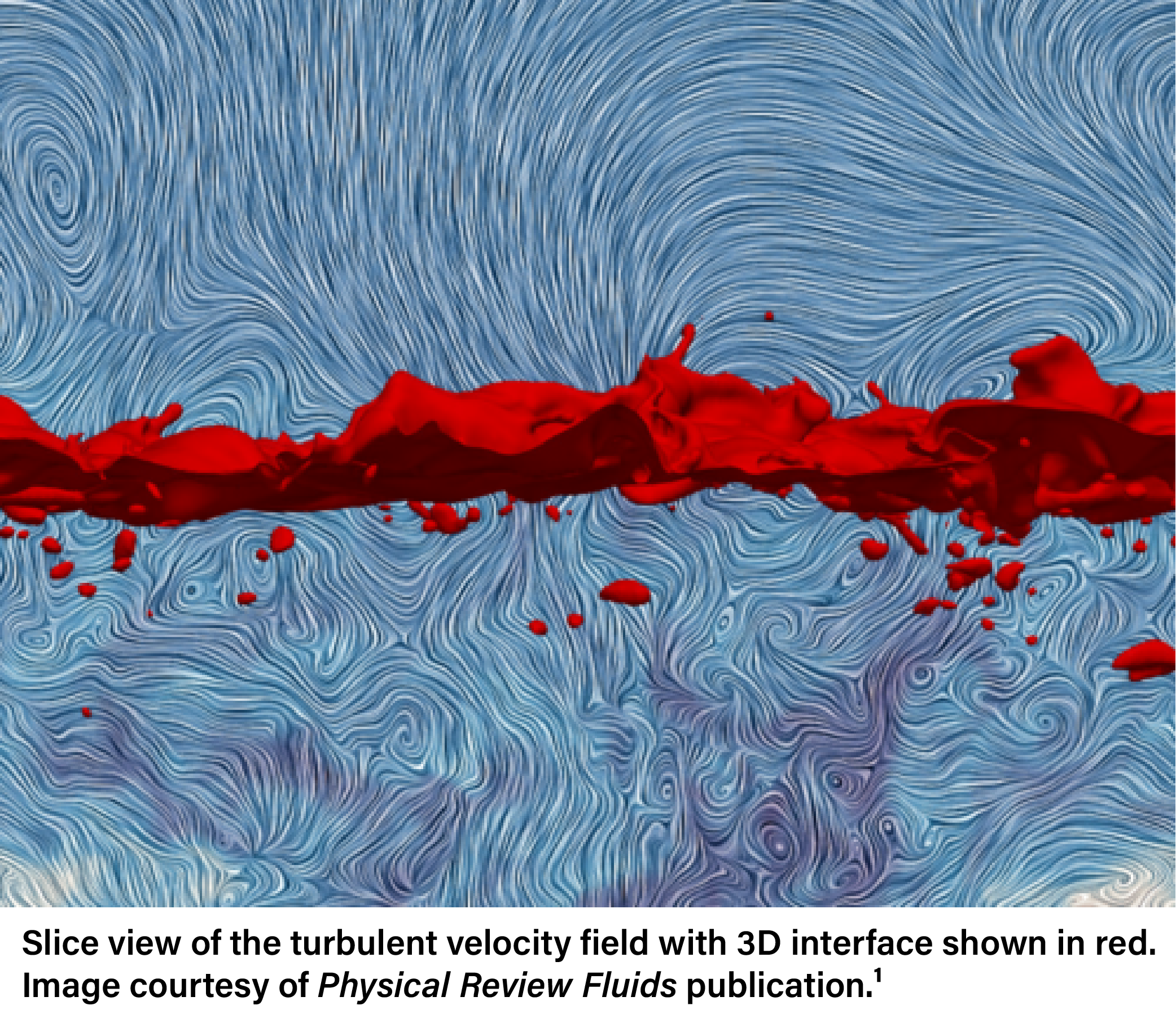Anvil used to advance research on two-phase flows
Researchers from The George Washington University used Purdue’s Anvil supercomputer to simulate fluid flows in order to elucidate the physics of turbulent bubble entrainment. Understanding this process will lead to practical applications in a variety of fields, including oceanography, naval engineering, and environmental science.
Andre Calado is a Graduate Research Assistant at George Washington University (GWU), working to complete his PhD in computational fluid dynamics (CFD). He, alongside his advisor Elias Balaras—a professor in the Department of Mechanical and Aerospace Engineering—wanted to advance the study of two-phase flows (air and water), specifically how turbulence underneath the water interacts with the water’s surface and the role this plays in air entrainment.
Air entrainment, or  bubble entrainment, is the process by which tiny bubbles are formed and trapped beneath the water’s surface. There are various mechanisms by which air entrainment occurs, but Calado’s research focused on self-aerating or continual aeration flows, a primary example being what happens in the vicinity of a ship’s wake. As a ship glides through the water it leaves a trail of waves behind on the water’s surface known as a wake. In this instance, the water’s surface is no longer flat (if it was before), but wavy and corrugated. Turbulence reaches the water’s surface, causing it to roll over on itself, much like a large ocean wave approaching the shore. The surface then pinches together, creating a pocket of trapped air—air entrainment. Air entrainment beneath the surface determines the wake's persistence and causes the archetypal acoustical signatures that accompany a wake. An excessive wake has a slew of negative consequences, including increased drag on a ship, reduced fuel efficiency, ecosystem disruption, and shoreline erosion. Understanding the underlying physics of air entrainment can lead to improvements in marine technology, which can help negate these consequences.
bubble entrainment, is the process by which tiny bubbles are formed and trapped beneath the water’s surface. There are various mechanisms by which air entrainment occurs, but Calado’s research focused on self-aerating or continual aeration flows, a primary example being what happens in the vicinity of a ship’s wake. As a ship glides through the water it leaves a trail of waves behind on the water’s surface known as a wake. In this instance, the water’s surface is no longer flat (if it was before), but wavy and corrugated. Turbulence reaches the water’s surface, causing it to roll over on itself, much like a large ocean wave approaching the shore. The surface then pinches together, creating a pocket of trapped air—air entrainment. Air entrainment beneath the surface determines the wake's persistence and causes the archetypal acoustical signatures that accompany a wake. An excessive wake has a slew of negative consequences, including increased drag on a ship, reduced fuel efficiency, ecosystem disruption, and shoreline erosion. Understanding the underlying physics of air entrainment can lead to improvements in marine technology, which can help negate these consequences.
Due to the turbulent and chaotic nature of bubble-laden flows, experimental measurements are nearly impossible. As such, CFD methods are necessary for providing high-resolution simulations of the physics of bubble entrainment.
“We’re looking  into the physics of bubble formation,” says Calado. “By using this high-fidelity simulation, we hope to learn how we can develop some correlational low-order models that can be used in more practical engineering applications.”
into the physics of bubble formation,” says Calado. “By using this high-fidelity simulation, we hope to learn how we can develop some correlational low-order models that can be used in more practical engineering applications.”
For traditional engineering problems, Reynolds-averaged Navier-Stokes (RANS) approaches are the typical CFD method employed by the industry. However, for two-phase flows, RANS models are known to fail in problems with large-scale interfaces. To address this issue, Calado and Balaras relied on direct numerical simulations (DNS), a much more computationally costly CFD method that resolves all relevant scales. To run these simulations the pair needed a high-performance computing (HPC) resource. For that, they turned to the Anvil supercomputer.
The first step in Calado’s process was to use Anvil for performance scaling tests.
“Basically we needed to see how the code scaled,” says Calado. “As you increase the computing resources—the number of cores, etc.—for a fixed problem size, you expect that the time for calculation will decrease in a linear fashion. So we did some basic tests and found that the code scaled very well.”
After running the performance scaling tests, Calado decided to run a “proof of concept” calculation of free surface air and water turbulence. This calculation was preliminary—Calado noted that the mesh he used was not as fine as it could have been, but he simply wanted to validate the code and demonstrate its performance in a parallel setting. The “proof of concept” calculation was successful, so Calado proceeded to run full simulations. These simulations provided Calado and Balaras with numerous insights into the physics of air entrainment, the details of which will help refine existing theoretical models and enhance the accuracy of low-order models.
“In an air entrainment process, you can have thousands to millions of bubbles,” says Calado, elaborating on the problem. “In the literature, you can find studies on what the distribution looks like for these bubbles. One thing that there is still margin for researchers to look into is for the smallest bubble size that can exist in these configurations.”
Calado continues, “Bubble size distribution follows one slope when looking at larger bubbles. Beneath a certain scale, about 1 millimeter in bubble size, the slope changes and the physics are different. For the tiniest bubbles, surface tension between the air and water becomes a stabilizing force, and so it's very hard to break up a bubble once it becomes very small. To create an accurate model that accounts for bubble size distribution, you really need these high-resolution, high-fidelity simulations, which is why we are using DNS. Our simulations are pushing the boundaries of what has been done so far.”
In regards to  computational performance, Calado and Balaras were very pleased with Anvil and the support that came with using the system. Due to the complex nature and sheer size of the calculations, Calado found that he needed longer run times for his simulations than are typically allowed in shared computing environments. Calado worked closely with the Anvil team to extend his run times even while utilizing a large number of cores. The Anvil team was very accommodating, which enabled Calado to conduct his research in an efficient manner.
computational performance, Calado and Balaras were very pleased with Anvil and the support that came with using the system. Due to the complex nature and sheer size of the calculations, Calado found that he needed longer run times for his simulations than are typically allowed in shared computing environments. Calado worked closely with the Anvil team to extend his run times even while utilizing a large number of cores. The Anvil team was very accommodating, which enabled Calado to conduct his research in an efficient manner.
“We’re happy to be using Anvil to perform these calculations,” says Calado. “It has been very helpful. These are very large computations—we’re talking about thousands of cores at a time. So we need these resources to do the fundamental research in order to understand the physics, and then hopefully apply what we learn to more practical engineering calculations.” Calado and Balaras plan to continue their research in the broad context of two-phase flows and free surface turbulence. Their goal is to tackle ever more complex problems to help close the gap between computational simulations and experimental observations. You can learn more about the pair’s research in their publication, High-fidelity simulations of submerged turbulence interacting with a free surface1 , published in the APS journal Physical Review Fluids.
To learn more about High-Performance Computing and how it can help you, please visit our “Why HPC?” page.
Anvil is one of Purdue University’s most powerful supercomputers, providing researchers from diverse backgrounds with advanced computing capabilities. Built through a $10 million system acquisition grant from the National Science Foundation (NSF), Anvil supports scientific discovery by providing resources through the NSF’s Advanced Cyberinfrastructure Coordination Ecosystem: Services & Support (ACCESS), a program that serves tens of thousands of researchers across the United States.
Researchers may request access to Anvil via the ACCESS allocations process. More information about Anvil is available on Purdue’s Anvil website. Anyone with questions should contact anvil@purdue.edu. Anvil is funded under NSF award No. 2005632.
References:
- Calado, Andre, and Elias Balaras. 2024. “High-Fidelity Simulations of Submerged Turbulence Interacting with a Free Surface.” Physical Review Fluids 9 (11). https://doi.org/10.1103/physrevfluids.9.110508.
Written by: Jonathan Poole, poole43@purdue.edu
